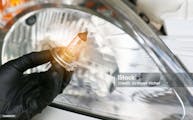Bright lights, big decisions! Headlights are considered “normal wear” items, which means they are used so much and so often that they are expected to wear out and be replaced. This presents you with a challenge: When the time comes to replace your headlights, which will you choose?
SHINING A SPOTLIGHT ON THE DIFFERENT TYPES
Manufacturers are always looking for ways to improve headlights — not only in how well they illuminate the road ahead but also in how good they look. The result is new innovations and more options for drivers. Let’s take a closer look at your options.
- Halogen headlights. You’ll find halogens are standard for most of today’s vehicles. These incandescent lights contain a combination of argon and nitrogen trapped inside the bulb with a tungsten filament. When an electric current passes through the filament, it heats up and glows. These headlights can withstand high temperatures.
- LED headlights. Once only found on high-end cars, LEDs are gaining in popularity, but they are not yet standard. An LED headlight is basically a semiconductor that releases light when a current is passed through it. They produce a brighter light but consume less power than halogen headlights.
- HID headlights. Also known as Xenon High-Intensity Discharge Headlights, they are usually found on luxury vehicles, and many drivers prefer how these lights look. These lights function like the bulbs of a neon sign; electricity arcs between two electrodes, causing xenon gas to react. They provide the brightest light of any of today’s readily available headlights. In fact, they are considered too bright for some jurisdictions (each state has its own laws governing headlights).
GOING FROM HALOGEN TO LED HEADLIGHTS OR HID HEADLIGHTS IS AN UPGRADE
Eventually, your headlights will need replacement. When your headlights are dim, flickering on and off, or do not come on at all, decision time has come: do you replace your existing halogen lights with more of the same, or do you upgrade?
You should always replace your existing bulbs with new ones that comply with manufacturer recommendations. You can find this information in your vehicle owner’s manual. Can’t locate your manual? No problem! A Jiffy Lube® technician can easily access this information for you.
Sometimes drivers who stick with halogen headlights handle the replacement themselves. The bulbs are affordable and going from old to new is a common Do It Yourself (DIY) project. Just remember not to get any fingerprints on the bulbs, because oil from your skin can cause the lights to burn out prematurely. Always refer to your vehicle owner’s manual before you start doing this yourself. If DIY simply isn’t your thing, feel free to bring your car to Jiffy Lube® and have a trained professional take care of replacing your headlights for you.
UPGRADING WILL NOT BE SO EASY
Typically you can’t just unscrew a halogen bulb and replace it with an LED or HID. In many cases they physically won’t fit. LED and HID bulbs are smaller than halogen bulbs, and each converts electricity into light differently. A conversion kit may need to be purchased and installed along with the bulbs. All this means is that there’s additional time and effort involved in upgrading your headlights.
HID HEADLIGHTS VS. LED HEADLIGHTS: HOW TO CHOOSE?
LEDs have their benefits:
- Bright shine with no glare
- Energy efficiency
- Instant light when turned on
So do HIDs:
- Long-lasting
- Energy efficiency
- A cool new look for your vehicle
LEDs have drawbacks, though:
- While the lights themselves don’t get hot, their assemblies and wiring harnesses do (a heatsink is included in the conversion kit to help alleviate this problem)
- They are brighter than halogen headlights and can be confused with hi-beams
And so do HIDs:
- Conversion/installation can be complicated and expensive
- Because of their harsh glare, they may not be legal in your state
- Startup can take time
MAYBE A LITTLE CONVERSATION WILL HELP YOU MAKE UP YOUR MIND
HID headlights vs. LED vs. halogen: it can be a tough decision. Considering coming in to discuss. Did you know exterior lights service is included with every Jiffy Lube Signature Service® Oil Change? A trained Jiffy Lube® technician will check all your external lights, including:
- Fog lights
- Parking lights
- Taillights
- Backup lights
- Brake lights
- Turn signal lights
- License plate lights
If one of these bulbs is burned out, the technician will suggest new bulbs that meet or exceed Original Equipment Manufacturer (OEM) requirements.
And, of course, your headlights will receive focused attention. If they appear yellow or cloudy, the problem could be dirty lens covers. A Jiffy Lube® technician will use a specially-formulated process to carefully remove grime and stains.
You can see why your next Jiffy Lube Signature Service® Oil Change is the ideal time to discuss HID headlights vs. LED vs. halogen. The technician will be familiar with your vehicle and your headlights. As you and the technician talk, expect a question or two about your driving style. This could be a deciding factor in whether or not to upgrade. For example, if you do a good deal more night driving than day driving, the switch from halogen to brighter HID or LED headlights might be worth the initial time and expense. No highlight service will begin until you approve the timeline and cost estimate.
You can also always request headlight care as a standalone service. Just visit one of the more than 2,000 Jiffy Lube® locations across the U.S and Canada.
DID YOU FIND THIS ARTICLE ILLUMINATING?
Jiffy Lube® experts regularly share their pro tips right here. Whether you have truck, SUV, minivan, or car care questions, you can turn to jiffylube.com for answers.
Learn More About Jiffy Light Bulb Inspection and Replacement
Please note: Not all services are offered at each Jiffy Lube® location. Please check with your local Jiffy Lube® service center or visit jiffylube.com for specific services offered.


